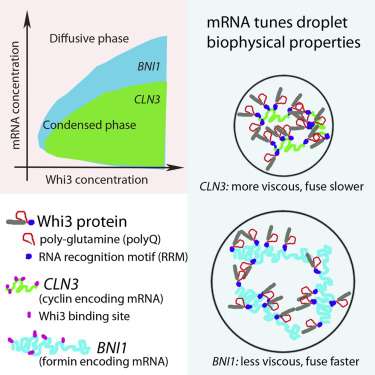Researchers shed light on protein-related diseases

Dartmouth researchers have found that some proteins turn into liquid droplets on the way to becoming toxic solids implicated in neurodegenerative diseases and other genetic disorders.
The findings, along with a series of related studies by scientists at other institutions, appear in the journal Molecular Cell.
The Dartmouth researchers studied proteins that have a massive expansion of a single amino acid, glutamine, typically associated with toxic protein solids. For example, neurodegenerative-linked proteins such as those in Huntington's disease have these amino acids, which makes the protein sticky. The researchers found that proteins like this undergo a transition into liquid droplets on the way to becoming toxic, fibrous solids. These liquid droplets are similar to the ones made when oil and vinegar are mixed to make salad dressing. The researchers suspect that cells use this liquid state for normal physiology, but under certain conditions the proteins transition again from liquid to toxic solids. These kinds of droplets have also been called "membrane-free" organelles because they lack a barrier and are highly dynamic unlike many organelles such as mitochondria or nuclei.
"We found that RNA, the molecule traditionally thought as the intermediate between DNA and protein, has a potent role in driving the formation of the liquid states," says senior author Amy Gladfelter, an associate professor of biological sciences. "They can drive the formation of droplets and give distinct physical properties to the droplets, which we think is important for how they are spatially arranged and function in the cell. It's exciting that this is an example of RNA encoding physical properties of these compartments or drops rather than just encoding proteins."
The results are important because the human genome is filled with proteins that have similar sequences and almost all understanding of these proteins so far has focused on pathological states.
"Our work, along with the other recent papers, find a form of these proteins that is relevant to normal cell function and yet takes advantage of the very sequences that are linked to diseases for their normal functions," Gladfelter says. "This type of mechanistic understanding of the protein's normal function is critical for understanding and treating a myriad of diseases linked to protein aggregation."
More information: Huaiying Zhang et al. RNA Controls PolyQ Protein Phase Transitions, Molecular Cell (2015). DOI: 10.1016/j.molcel.2015.09.017



















